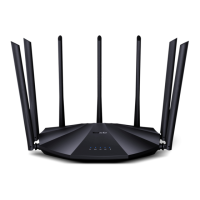It is used to enable or disabled the PPTP server.
When it is enabled, the router functions as a PPTP server, which can accept the
connections from PPTP clients.
It specifies the range of IP address range within which the PPTP server can assign to
PPTP clients. It is recommended to keep the default settings.
It is used to enable or disable 128-bit data encryption. The encryption settings should be
the same between the PPTP server and PPTP clients. Otherwise, the communication
cannot be achieved normally.
It specifies the VPN user name and password, which the VPN user needs to enter when
making PPTP dial-ups (VPN connections).
It specifies the connection status of the VPN connection.
The available operations include:
⚫
: It is used to add new PPTP user accounts.
⚫
: It is used to disable the PPTP user account.
⚫
: It is used to enable the PPTP user account.
⚫
: It is used to delete the PPTP user account.
8.1.2 Enable internet users to access resources of the LAN
Scenario: You have set up a FTP server within the LAN of the router.
Goal: Open the FTP server to internet users and enable them to access the resources of the FTP
server from the internet.
Solution: You can configure the PPTP server function to reach the goal. Assume that:
− The user name and password that the PPTP server assigns to the client are both
admin1.
− The WAN IP address of router is 113.88.112.220.
− The IP address of the FTP server is 192.168.0.136.
− The FTP server port is 21.
− The FTP login user name and password are both: JohnDoe
Please ensure the WAN IP address of router is a public network. This function may not work on a host
with an IP address of a private network. Common IPv4 addresses are classified into class A, class B and
class C. Private IP addresses of class A range from 10.0.0.0 to 10.255.255.255; Private IP addresses of
class B range from 172.16.0.0-172.31.255.255; Private IP addresses of class C range from 192.168.0.0-
192.168.255.255.

